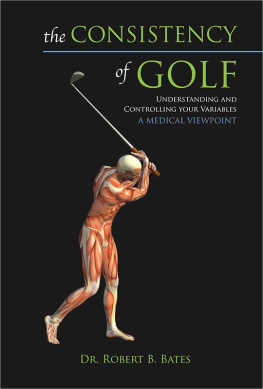The Consistency Of Golf:
Understanding & Controlling Your Variables
A Medical Viewpoint
Dr. Robert B. Bates

Numerous tips, based on current medical research, that will immediately take shots off your game.
The Consistency Of Golf:
Understanding & Controlling Your Variables
A Medical Viewpoint
Copyright 2017 Dr. Robert B. Bates
All rights reserved. This book or any portion thereof may not be reproduced or used in any manner whatsoever without the express written permission of the publisher except for the use of brief quotations in a book review.
ISBN: 978-1-54391-613-3
Preface
You are about to begin a journey that will transform your game of golf and make you a much more consistent golfer.
The newest medical research is allowing us to understand exactly how you can be efficient and repetitive in motor activities by better understanding brain function.
Your brain creates maps of many different body parts with reference frames to know your position in your environment. These maps are called somatotopic maps and you form them for your head, head on neck, neck on body, hands, feet and internal structures like blood vessels etc. You literally have maps for everything and that is how your body can regulate movement of you in space and of internal movements like blood flows etc.
Your inner ear (vestibular system) gives information to the brain about movement of your heads angular and translational velocities. Your skin, muscles, tendons, ligaments and joint receptors (somatosensory system) give information to your brain about body movements. Your eyes give information to your brain about your movement in your environment. This information is integrated by your brain and creates an accurate awareness of you and your body parts in your environment as well as the dynamic changes of you in your environment. This information is critical to internal and external body function. The more accurate information your brain receives, the more accurate you can move in your environment.
Any aberration of the incoming information or incorrect processing of the information creates a mismatch of your balance, vision, position in space and your space around you. We now understand these systems well enough to correct some of the mismatch and therefore create more accurate awareness and subsequent function. These are exciting times in functional neurology!
The information in this book will give you the best possible chance of creating accurate motor function in your environment. Golf is a game that anyone can play. I have treated patients from the ages of 6 to 96 that have played the game of golf. However, to be a good golfer is entirely a different matter. Golf is one of the sports that you can begin playing immediately, even though at a very poor level, and continue to excel with practice and commitment. This is untrue for many other sports, where you have to have a certain basic skill to play the game.
For instance, you cannot play hockey unless you learn how to skate and perform some other basic skills. You cannot play tennis unless you can hit the ball and return it to some degree. Golf, however, is a game that almost anyone can muster the limited skill necessary to hit a stationary ball on the ground, no matter how many times it takes to get to the hole.
Golf is a game that depends upon your individual skill. You are playing against yourself, even though your score determines whether you beat an opponent. You, therefore, are under control, and there is very little luck involved, other than some minimal weather considerations. The final outcome, therefore, is relative to your particular degree of skill and execution of the game. There are very few factors altering the end result that you are not in control of.
Simply put, playing golf is to hit the ball which propels it to a location dependent upon how it is struck. There is no other magical consideration, and it can be broken down into a game of pure Newtonian physics. If the club head hits the ball properly at the correct speed without producing spin vertically or horizontally, the ball will go straight to its desired location. Why, then, are there not more professional golfers that play a consistent game? That is what this book will attempt to explain in considerable detail. There are a significant number of variables which alter consistency of the game that you can control if given the understanding.
We have all hit the ball with precision, sending the ball exactly where we wanted it and imagined it to go. We seem to know immediately when striking the ball if it felt right. This feedback tells us that our predicted motor command (efferent copy) was accurate or not. This allows us to learn. Our brain is always calculating how accurate our activity was in relation to the efferent copy or preprogrammed motor command. We have also hit the ball knowing immediately, before seeing its path, that it was a horrible shot. Why was the efferent copy incorrect? Wouldnt it be marvelous to understand as many of the variables as possible and to increase the consistency of your motor commands? We will see that there are many factors that can be controlled to help increase your consistency.
We would like our swing to be as accurate as possible, and the only way that this can happen is if we can reproduce a swing over and over again, knowing its potential outcome (creating efferent copy that is accurate). We would like our swing to be precise, like a long-barreled rifle, using a precision made bullet containing the exact amount of firing power with each shot. If we can produce a consistent swing, we will not only play a much better game of golf, but enjoy it much more as well.
By reading this book, you will understand that it is impossible for you to have the swing of Jack Nicholas or Arnold Palmer or any other professional golfer. You are a unique person in mind and body unlike anyone else and this creates the golfer that you are and will be. It is a mistake to try to copy the swing of someone else who has many variables that are different than yours. This is not to say that you cannot be a professional golfer, but only that you will have your own mental and physical mechanism and you cannot completely emulate another golfers style. Your nervous system is different than anyone elses and your ability to learn movement patterns is specific to you. Your body proportions are your own with a difference in weight to height ratios and lengths of bones, and therefore lever arms. Your muscle strength and flexibility, speed of muscle contraction and endurance are your own. Your response to temperature changes, stress response, vision, upper neck function, posture, inner ear mechanism, and many other factors are specific to you. You must, therefore, develop your own style, and that is what this book will allow you to do.
This book is not designed to go through the various idiosyncrasies of making different shots and specifics of any individual professional player. We will cover the basics which I feel are important and give you further knowledge to allow you to make your own personal variables work for you. We do not want you to try to emulate or copy any professional player, since this will have a detrimental effect to your overall game. You can prove this to yourself by looking at the different professional players and finding quite a variety of technique depending upon what has worked best for their individual body type and functional ability.












